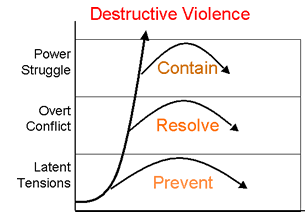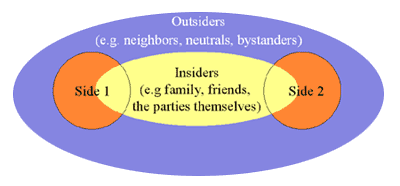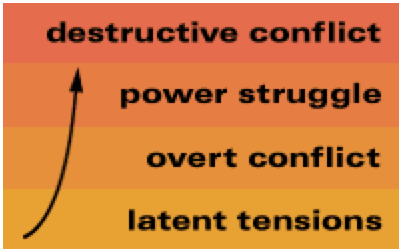Bridge-Builder – Forge Relationships Across Lines of Conflict
Good relationships are key to preventing conflict. Anyone can help build bridging relationships across natural divides. A relationship operates like savings in the bank; whenever an issue arises, the parties can dip into their account of goodwill to help deal with it. Often not a discrete activity, bridge-building takes place all around us, sometimes without us even perceiving it – at family meals, on school projects, in business transactions, and at neighborhood meetings.
Creating cross-cutting ties
Nothing can escalate conflicts faster than the absence of communication, trust, and relationship. Ignorance creates and exacerbates fears. Misunderstandings accumulate and stereotypes build up. People attribute the worst intentions to others’ behavior. Cross-cutting ties, relationships that cut across a line of potential or actual conflict, can serve as a safety net to catch escalating tensions. Cross-cutting ties can build trust and establish natural avenues for communication.
Anyone, no matter what their occupation, can help build bridging relationships across natural divides. The Bridge-Builder is the one who invites two estranged family members who have not talked in years to the same celebration or who invites two business rivals for a golf game. The Knowledge Revolution facilitates the process of building bridges on a global scale. As more and more young people spend time living as exchange students in other countries, as more and more business people make deals across borders and visit partners in their homes, as more and more tourists travel to foreign lands, stereotypes are replaced by genuine understanding. The more bridges we build across the chasms of culture and distance, the harder it becomes to demonize others.
Develop joint projects
One intentional way to forge cross-cutting ties is to create joint projects.
- As parents know, telling two children to get to know each other can be an awkward proposition; but assign them a common task like washing the dishes, and soon they will be grumbling together about adults and carrying on a lively conversation.
- Similarly, a manager faced with two rivalrous sales representatives can put them to work as a team on the same important account.
- In a classic 1950s experiment with two groups of boys at a summer camp, psychologist Muzafer Sherif demonstrated that a common task, such as jointly pushing a truck to get its engine started, helps reduce negative stereotypes and build friendships – far more effectively, in fact, than simply bringing the boys together to socialize.
In communities around the United States, a growing number of people are getting together across ethnic, class, and ideological divides to tackle concrete problems of mutual interest:
- In Sonoma, California, Hispanic farmworkers and middle-class whites have learned to work together by supporting each other’s favorite causes – from education to affordable housing.
- In southern Oregon and northern California, environmentalists and loggers, long-time foes, have forged partnerships to plant trees, protect streams, and start new forest-product businesses. “This is not about preservation vs. exploitation,” declares a member of a third-generation logging family. “This is about communities – forest communities and people communities.”
- Perhaps the most substantial exercise in bridge-building in the world is the joint project of European integration spearheaded by Jean Monnet after the two bloodiest wars in world history. After World War II, he managed to persuade two bitter and ancient enemies, France and Germany, and a half dozen of their smaller neighbors, to pool their coal and steel resources. Monnet reasoned that joint control of the resources most essential to industrial development and modern war would make it difficult for the participating nations to go to war once again.
- And history has proven him right. From this first step has evolved the European Economic Community, the European Parliament, the European Court of Justice, the European Central Bank – the institutions of a confederated Europe. Disputes within the European Community continue to spring up but it has become unthinkable to use force to resolve them. Europe, the epicenter of war in the twentieth century, has become an experiment in coexistence and cooperation.
Foster genuine dialogue
Dialogue aims not to convert others or to reach agreement on the issues, but rather to promote mutual understanding and build relationships that can prevent escalation into violence. They provide a safe atmosphere in which people can talk openly and deeply about their differences, and perhaps discover their underlying commonalities.
Dialogue is demanding. It is much easier to remain at a distance casting stones at the other. It takes courage to face the pain of human differences and to talk in a vulnerable fashion about what really matters. Yet, in conflicts large and small, dialogue has the power to change attitudes. While it may seem obvious to outsiders, the parties often are amazed to discover that their enemies are human like themselves, and sometimes end up concluding that, placed in the same position, they might feel and act the same way.
- In Los Angeles, the city sponsored a series of interracial discussions in all parts of the city to try to ease tensions after the O. J. Simpson murder trial. Churches, unions, and businesses became involved. “It’s amazing how little we really know about each other,” commented one participant. “I’ve seen two riots in my life,” declared another. “This is riot prevention work. It has more potential than anything I’ve seen.”
Bridge-builders can foster dialogue on the streets.
- In Omaha, Nebraska, a small group of African-American fathers came together under the name “Mad Dads” to walk the streets and reconnect with young people involved in drugs and violence. “We just started talking with them,” explains the co-founder. “What would you like to see change around here? We listen to them. We get them engaged expressing themselves. Then we get into feelings. ‘How do you feel about so and so? What about your father?'” Mad Dads has spread to twelve states across America – with tangible results. As one government official explains, “In 1990, there were sixteen people killed in one single neighborhood. This year there has been only one killing. . . . Mad Dads taught us that ours was not a black or white problem but a community problem. The only way to help a community is for the community to help itself – one house, one block at a time.”
Genuine dialogue can take place every day between potential adversaries – husbands and wives, workplace rivals, or neighbors at odds. Acting as third parties, even if we say very little, we can foster dialogue by bringing the parties together in a comfortable and neutral place – a couples counselor’s office, a conference room, or a friend’s living room. If emotions threaten to explode, we can intervene to cool things down and keep the conversation going. We can serve, in short, as a container for contention.
Resources
- Search for Common Ground
- PeaceNet
- The Online Healthy Relationships Project
- The Giraffe Project
- The Center for the Common Good
- PeaceBuilders
Brief bibliography
- Kelman, H. (1992). “Informal Mediation by the Scholar/Practitioner.” In Bercovitch, J. and J. Rubin, eds. Mediation in International Relations. New York: St. Martin’s Press. PP. 64-96.
- Kelman, H.C. (1993). “Coalitions across Conflict Lines: The Interplay of Conflicts within and between the Israeli and Palestinian Communities.” In Worshel S. and J. Simpson, eds. Conflict between People and Groups. Chicago: Nelson-Hall.
- Ury, William (2000). The Third Side:Why We Fight and How We Can Stop. New York: Penguin.




